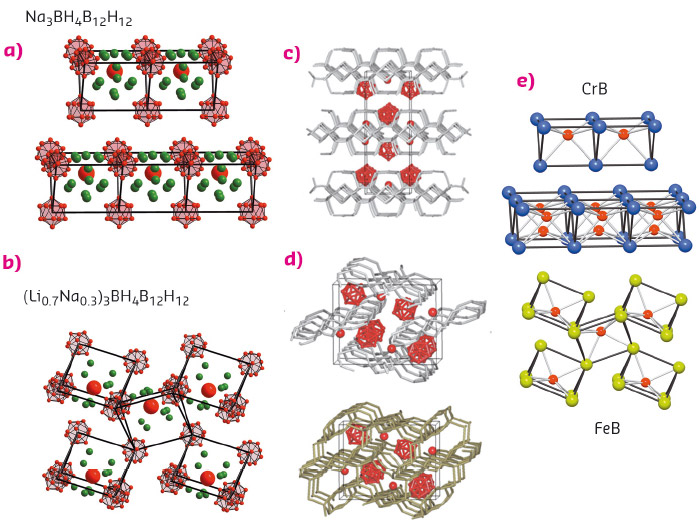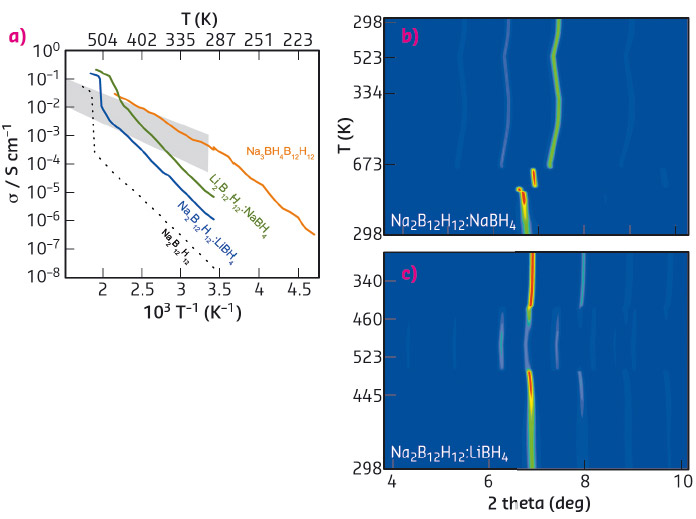- Home
- Users & Science
- Scientific Documentation
- ESRF Highlights
- ESRF Highlights 2015
- Structure of materials
- Mixed-anion metal boranes for solid state Na and Li electrolytes
Mixed-anion metal boranes for solid state Na and Li electrolytes
Na-based materials are becoming competitive alternatives to Li-ion batteries. For all-solid battery systems, electrode and electrolyte materials need to be developed and tested. Simple packed compounds have been discovered based on the tetrahydroborate [BH4]– (borohydride) and the dodecahydroborate [B12H12]2– (closoborane) anions with very high conductivities for Li+ and Na+ cations comparable to NASICON-type materials, sulphide-glasses and rivalling even superionic β-alumina.
Much battery research is currently oriented towards the development of all-solid state concepts, where the liquid electrolyte, usually based on an organic solvent that dissolves the mobile species, e.g. Li+ in Li-ion batteries, is replaced by a polymer or solid electrolyte. The aim is to avoid the safety issues arising with conventional, flammable liquid electrolytes. While such modifications eliminate the risk of dendritic growth or failure due to bad electrochemical and thermal stability of the cell, they pose a challenge with respect to the mobility of charge carriers, commonly orders of magnitude lower in the solid state than in the liquid.
Li-ion batteries are currently considered the benchmark technology for mobile applications. However, tremendous efforts are being invested on a global scale to take both mobile and stationary applications beyond lithium. These targets include large-scale implementations such as grid energy storage, where low power density can be compensated for by quantity or size. Hence, Na-based materials could become competitive alternatives. For all-solid battery systems, electrode and electrolyte materials need to be developed and tested.
This study deals with the solid-state electrolyte. Electrochemically stable materials with a large operating voltage window and a high conductivity at room temperature (RT) are required, potentially allowing a battery-design that employs metallic Na as anode-material, thus providing high capacity. Ionic conduction in a solid-state electrolyte is promoted by vacancy-driven mechanisms as well as structural dynamics. In particular, the bcc anion lattice has been found to favour ionic mobility. Novel materials that contain poly-anions [ABy]n–, where the structure is rationalised as a salt, are also promising. In such compounds the energy barrier for ionic conduction is lowered due to the rotational mobility of the poly-anion, which acts as a “paddle wheel” on the mobile ionic species, loosely bound in the host framework.
A number of solid state boranes are available to materials scientists exploring the conductive properties of complex hydrides. The present investigations were inspired by reports on the superionic high-temperature (HT) phases of Na2B12H12 and Na2B10H10. These phases reach HT-conductivities above 0.01 S cm–1, however they are not stable at RT.
Here, we explore anion-mixing of the tetrahydroborate [BH4]– (borohydride) and the dodecahydroborate [B12H12]2– (closoborane) anions, attempting to build stable anion-sublattices of high crystal symmetry using the larger closoborane, while implementing additional rotational mobility with the borohydride anion. We discovered simple packed compounds and provide a roadmap based on crystal chemistry arguments to explore the phase diagram Na3BH4B12H12 – Li3BH4B12H12 in a search for further anion-mixed single- and double-cation conductors.
 |
|
Fig. 42: (a) Crystal structure of Na3BH4B12H12 and (b) (Li0.7Na0.3)3BH4B12H12; mobile species (Li+,Na+) in green, boron as red spheres, [B12H12]2– as molecule. (c) and (d) Conduction pathways for Na (grey) and Li (brown). (e) Comparison with the prototypical relationship between CrB and FeB; boron in red. |
Na3BH4B12H12 and (Li0.7Na0.3)3BH4B12H12 show very high conductivities of close to, and above, 10–1 S cm–1 at 500 K (Figure 42). To monitor HT reactions forming the solid electrolytes, we chose to work with the 2D Dectris Pilatus detector at BM01A, which allows very high counting statistics to be acquired at a fast rate (Figure 43). The crystal structures of the novel materials (Figure 42) provide evidence of localisation of the mobile species, Na+ and Na+/Li+, respectively, in the structural fragments containing the borohydride anion, supporting the concept of anion-engineering, one of the initial aims of this project.
 |
|
Fig. 43: (a) Ionic conductivities obtained from impedance spectroscopy. Typical NASICON and β-alumina materials in the shaded field. (b) In situ temperature-dependent diffraction data for the reaction forming Na3BH4B12H12 and (c) (Li0.7Na0.3)3BH4B12H12. |
Topologically, a 1-dimensional conduction path is accessible to the Na-species in (Li0.7Na0.3)3BH4B12H12, while a 2-dimensional path is available to Li (Figure 42), theoretically both species can conduct. However, the material is subject to a reversal chemical reaction upon cooling, and dissociates to its precursors. Upon heating, it again forms the superionic phase at 500 K (Figure 43).
Na3BH4B12H12, on the other hand, is formed by a reaction between Na2B12H12 and NaBH4 at 673 K, and is stable at RT. The 2D conduction pathways allow this phase to reach RT-conductivity values close to 10–2 S cm–2, comparable to NASICON-type materials, sulphide-glasses and rivalling even superionic β-alumina. Next to the electrochemical stability of Na3BH4B12H12 (up to 10 V) and the favourable mechanical properties due to the material softness, the high RT-conductivity implies the potential use of Na-metal as anode. Furthermore, the reducing nature of the material minimises the risk of surface reactions on the electrode.
Our structural analyses have revealed a most striking similarity to the relationship between different stacking variants of metal-borides, which points towards the existence of further electrolytes in the Na3BH4B12H12 – Li3BH4B12H12 diagram, simply related by polytypism.
Principal publication and authors
Superionic conduction of sodium and lithium in anion-mixed hydroborates Na3BH4B12H12 and (Li0.7Na0.3)3BH4B12H12, Y. Sadikin, M. Brighi, P. Schouwink and R. Černý, Adv. Energ. Mater. 1501016 (2015); doi: 10.1002/aenm.201501016.
Laboratory of Crystallography, Department of Quantum Matter Physics, University of Geneva (Switzerland)



